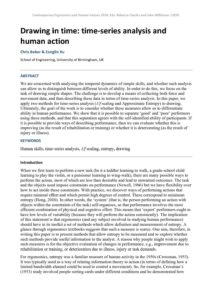| Document | Author Chris Baber & Zonglin Xu |
| Abstract We are concerned with analysing the temporal dynamics of simple skills, and whether such analysis can allow us to distinguish between different levels of ability. In order to do this, we focus on the task of drawing simple shapes. The challenge is to develop a means of collecting both force and movement data, and then describing these data in terms of time-series analysis. In this paper, we apply two methods for time-series analysis (1/f scaling and Approximate Entropy) to drawing. Ultimately, the goal of the work is to consider whether these measures allow us to differentiate ability in human performance. We show that it is possible to separate ‘good’ and ‘poor’ performers using these methods, and that this separation agrees with the self-identified ability of participants. If it is possible to provide ways of describing performance, then we can evaluate whether this is improving (as the result of rehabilitation or training) or whether it is deteriorating (as the result of injury or illness). |

